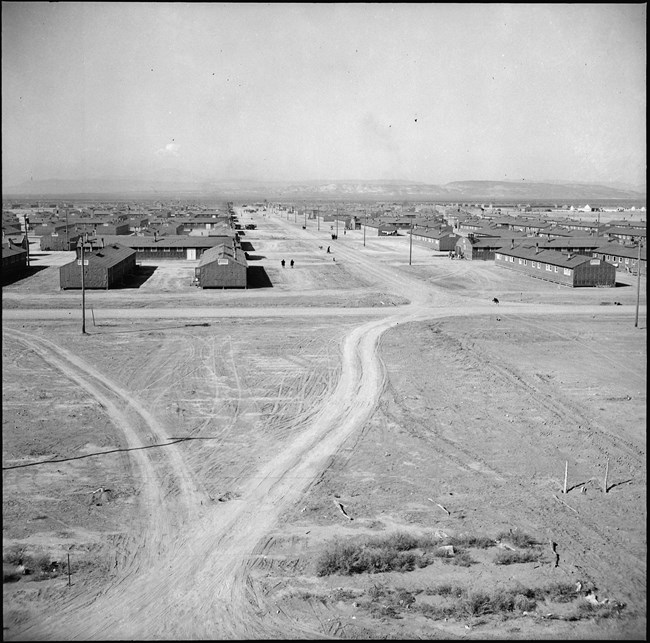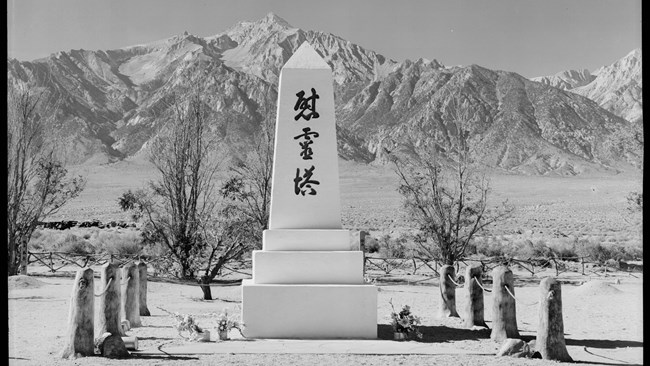Last updated: December 16, 2024
Article
Buddhism Under Japanese Incarceration During WWII
Religion is crucial to the history of Japanese American incarceration during World War II. Many Japanese Americans turned to their beliefs for comfort in a time of upheaval. Buddhists faced particular challenges. Many American authorities considered Buddhism to be alien, suspicious, and potentially disloyal. Nevertheless, Buddhists held on to their traditions. They developed new forms of religious practice and forged interfaith bonds. Their beliefs helped support them through the hardship and injustice of their wartime experience.

Photo by Tom Parker, courtesy National Archives and Records Administration.
Americanizing Buddhism at Central Utah Relocation Center (Topaz)
Many Buddhists took pains to prove their loyalty to the US government as they navigated the new reality of incarceration. They sought to show their desire to adapt to American society. One such organization was the Buddhist Mission of North America (BMNA). Its bishop, Ryotai Matsukage, was evacuated from San Francisco and imprisoned at Central Utah Relocation Center, also known as Topaz.
Matsukage reopened BMNA headquarters in camp. The organization changed its name to the "Buddhist Churches of America." It also adopted English as its official language and cut ties with temples in Japan. Matsukage hoped that these measures would help the group avoid harassment from camp authorities. Buddhists at Topaz and in other camps also adopted changes to daily religious practices in the name of Americanization. They began using terms like “reverend” and “church” instead of “priest” and “temple.” Some adapted traditional chants into hymns designed for choral singing. They collected them into songbooks for use in worship.
Some Japanese American Buddhists decried these changes. But others saw them as part of a process of adaptation essential to Buddhist teaching. They welcomed the chance to show that Buddhism belonged in a dynamic and pluralistic America. In the words of a young Buddhist incarcerated in Arkansas:
“By our actions and deeds, the American public will come to know Buddhism is nothing to fear and suspect but a religion that will be an asset to a greater and finer America.”
Central Utah War Relocation Center (Topaz) was added to the National Register of Historic Places on January 2, 1974 and designed a National Historic Landmark on March 29, 2007.

Photo by Ansel Adams.
Interfaith Cooperation at Manzanar War Relocation Center
Buddhist Japanese Americans outnumbered Christians in incarceration camps. However, camp authorities usually supported and encouraged Christian worship. They often treated Buddhism coolly. Christian and Buddhist leaders in many camps worked hard to bring their two communities together. They aimed to create a shared sense of morale and purpose.
At Manzanar War Relocation Center in California, this joint effort is embodied in the Manzanar Cemetery Monument. Erected in 1943, the white concrete obelisk was planned by the camp’s Town Hall Committee and Buddhist and Christian ministers. Leaders asked Ryozo Kado to design the monument. Kado was a Catholic stonemason and garden planner. The characters "I-Rei-To" adorn the front of the obelisk. The traditional inscription means “Monument to Venerate the Spirit of the Deceased.” The Rev. Shinjo Nagatomi, a Buddhist priest, spent weeks perfecting the calligraphy for the engraving. Donations from families in the camp raised $1000 for the monument’s construction. A dedication ceremony on August 14, 1943 coincided with the Buddhist Obon festival, a holiday to honor ancestral family spirits.
The monument remains standing today. It provides a focal point for visitors to Manzanar National Historic Site. Each year, participants in the Manzanar Pilgrimage gather at the monument for an interfaith service that pays tribute to those who lived and died at the camp.
Manzanar War Relocation Center was added to the National Register of Historic Places on July 30, 1976 and designed a National Historic Landmark on February 4, 1985. In 1991, the US Congress designated Manzanar a National Historic Site.
Click here to view a lesson plan based on this article.
Manseau, Peter. “The Complex Role Faith Played for Incarcerated Japanese Americans During World War II.” Smithsonian Magazine, Feb. 15, 2019. https://www.smithsonianmag.com/smithsonian-institution/complex-role-faith-incarcerated-japanese-americans-during-world-war-ii-180971509/
Molina, Alejandra. “In WWII, Japanese Americans’ faith came under suspicion and helped them survive their incarceration.” Religion News Service, April 29, 2022. https://religionnews.com/2022/04/29/how-religion-played-a-role-in-wwii-incarceration-of-japanese-americans-and-how-it-helped-them-survive-it/
"Tradition Influences a Blended Culture." Prisoners at Home: Everyday Life in Japanese Internment Camps. Digital Public Library of America. https://dp.la/exhibitions/japanese-internment/religious-practices/tradition
Rhude, Kristofer. "Buddhism in Japanese American Internment Camps -- Case Study." Religion and Public Life, Harvard Divinity School. https://rpl.hds.harvard.edu/religion-context/case-studies/minority-america/buddhism-japanese-american-internment-camps#:~:text=For%20many%2C%20Buddhism%20provided%20a,camps%20what%20they%20could%20carry
Williams, Duncan Ryūken. American Sutra: A Story of Faith and Freedom in the Second World War. Cambridge, MA: The Belknap Press of Harvard University Press, 2019.
Article by Ella Wagner, PhD, Cultural Resources Office of Interpretation and Education.
Tags
- manzanar national historic site
- buddhism
- world war ii
- japanese american incarceration
- japanese american history
- aapi
- aapi history
- asian american and pacific islander heritage
- asian american and pacific islander history
- religion
- religion and wwii
- manzanar war relocation center
- utah
- california
- world war ii home front
- wwii home front
